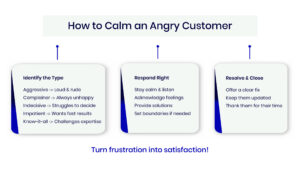An angry customer usually complains about your product or service. Sometimes, they become abusive and vent their frustration. To deescalate such situations, your customer support agents should listen to them attentively (without interrupting), show empathy and acknowledge their frustration. They should stay calm and offer clear solutions instead of saying a “no”.
For most business owners, angry customers represent God’s wrath! Isn’t it? Yes, dealing with them can be stressful. A Forrester study shows that 35% of customers feel angry or frustrated when dealing with customer service representatives in brands.
But, are there ways to defuse angry customers? Fortunately, there are many! With the right approach, your agents can calm the situation and restore customer satisfaction.
Ideally, every customer service agent should know how to manage frustration and turn negative experiences into positive ones. For CX leaders, whether you are a VP or Director at a D2C company with $5M+ revenue, equipping agents with the right de-escalation training can improve retention and brand loyalty. In this article, let’s understand how to deescalate an angry customer. We will study five major types of upset customers and check out some proven tips for de-escalating arguments.
Why Do Customers Get Angry?

Customers can be upset for many reasons:
- They have had a bad day, and their frustration spills over into the conversation.
- An upset customer’s anger is due to their natural behaviour
- There is a real issue with your product or service
Instead of just answering their questions, a good customer service agent should understand why they are upset and work on a solution to make them feel better.
5 Types of Angry Customers and How to Handle Them
No matter how good your service is, some customers will still be unhappy! However, by understanding the different types of angry customers, you can better deescalate a situation. Let’s learn about them and see how you would handle such angry customers:
1. The Aggressive Customer
These customers get angry quickly. They often shout or use harsh words. They believe their problem is the most important and may even be rude.
Want to know how to de-escalate an angry customer? The best way to handle them is to:
- Stay calm
- Listen without interrupting
- Avoid arguing
- Apologize for their frustration and offer a solution
If they become too aggressive, set boundaries. Politely let them know that respectful communication is necessary. By keeping a professional tone, your customer support agents can defuse angry customers. This is why many CX leaders in the US and UK stress on calm, consistent communication as part of their support strategies.
2. The Habitual Complainer
These customers always find something to complain about, no matter what. They may criticize:
- Your prices
- Product quality
- Even small things like packaging
It can be exhausting to deal with them, but the key is patience. Your agents should:
- Listen to them carefully
- Acknowledge their concerns
- Assure such angry customers that their feedback is valued
If possible, offer reasonable solutions. CX teams at consumer brands often use complaint tracking and analytics to identify repeat patterns, turning recurring complaints into improvements.
3. The Indecisive Customer
These customers struggle to make decisions. They ask a lot of questions about your product, price, and quality but hesitate to make a purchase. They may keep changing their minds, making the process longer.
To handle them:
- Be patient and guide them through their options
- Provide clear and honest information
- Offer recommendations based on their needs
- Try to give them a sense of urgency (like limited-time offers) to help them decide faster

4. The Impatient Customer
These customers want quick solutions. Usually, they do not understand delays or business limitations. They get frustrated if things don’t happen immediately and might even threaten to go to a competitor.
The best way to handle them is to:
- Acknowledge their urgency
- Explain the situation clearly
- Offer the fastest possible solution
For consumer brands in the US, UK & Australia, responsiveness is non-negotiable. Many CX Directors adopt SLAs and real-time reporting to meet consumer expectations.
5. The Know-it-all Customer
These customers act like they know everything. They may:
- Dominate the conversation
- Question your expertise
- Try to get a better deal by pointing out flaws in your service
To handle them, your agents must acknowledge their knowledge but politely correct any misinformation. Also, they should provide facts and explanations without sounding defensive. Back statements with product data or benchmarks so that customers see proof, not opinion.
How to Deescalate an Argument?

Dealing with angry customers is a common challenge for any business. However, handling them professionally can turn a negative experience into a chance to build trust and loyalty.
Research by Harvard Business Review confirms that 40% of customer complaints still happen over the phone, where tone and empathy matter more than speed. Therefore, you must train your customer support agents with the right communication strategies.
Below are some popular customer service deescalation techniques that your agents can practice:
1. Listen Attentively Without Interrupting
When a customer is upset:
- Let them speak without cutting them off
- Don’t rush to respond
- Avoid jumping to conclusions before they finish speaking
By listening carefully, you can make them feel heard. This defuses angry customers.
2. Show That You Care and Understand
Customers want to feel valued, not just heard. Show empathy by acknowledging their frustration and offering support. According to PwC, 50% of customers switch brands after just one bad experience.
3. Focus on Solutions Instead of Saying ‘No’
When dealing with angry customers, avoid saying a direct “no.” Instead, shift the conversation toward solutions. CX leaders use positive scripting such as “Yes, and…” instead of blunt refusals, which helps reduce escalation.
4. Stay Calm, Even with Difficult Customers
It is natural to feel stressed when facing an angry customer. But staying calm is a highly underrated deescalation technique. Senior managers at D2C companies often emphasize resilience coaching in onboarding, ensuring agents maintain composure under pressure.
5. Don’t Take It Personally
When customers are frustrated, remember their anger is directed at the situation, not you. Staying professional allows agents to resolve even the toughest conversations.
How To Deescalate an Angry Customer Script?
Till now, you must have understood how to de-escalate a customer. But is your team ready? To let your customer support agents perform better, you can train them on ready-to-use responses.
Below are six practical script examples, proven across 200K+ customer interactions, that can professionally defuse angry customers:
1. Greeting Customers
- New Customer: Hi [Customer Name], welcome! How can I assist you today?
- Returning Customer: Hello again, [Customer Name]! Are you still facing the same issue, or is there something new I can help with?
- Customer Already Explained Their Issue: Hey [Customer Name], I see you’re reaching out about [mention issue]. Let me check and get back to you.
2. Asking Customers to Wait
- At the Start of the Chat: I need 2–3 minutes to check this for you. Thanks for waiting!
- When They Ask for an Update: Sorry for the wait, I’m still looking into it. Thanks for your patience!
3. When You Need More Information
- For Specific Details: Can you please provide [mention required info]?
- To Understand the Issue Better: I see you’re having trouble with [product/service]. Can you explain what’s happening and what you’ve tried so far?
4. Involving Other Team Members
- If You Can Get the Info Yourself: I need to check with [department/person] about this. I’ll update you in a few minutes.
- If Another Team Can Help Better: Our [department] team is best suited for this. I’ll connect you with them now.
- If a Senior Representative is Needed: I need to escalate this to a senior team member. Please hold while I connect you.
5. Handling Angry Customers
- When They Are Frustrated but the Issue is Unclear: I’m really sorry you’re facing this. I understand how frustrating it must be. Can you share more details so I can help?
- When the Issue is Clearly Our Fault: You’re absolutely right. This shouldn’t have happened. I’ve escalated the issue and will ensure it’s resolved. As an apology, we’d like to offer [discount/refund/voucher]. Would that work for you?
6. Ending the Conversation
- If Your Team Needs Time to Fix the Issue: Thanks for your patience, [Customer Name]. Our senior team is working on it, and we’ll update you in 2 business days. Anything else I can help with?
- If the Issue is Resolved: Thanks for your patience, [Customer Name]. I hope everything works smoothly now. Let me know if you have any feedback.
Turn Customer Fury into Loyalty! Choose Atidiv.
Handling angry customers requires patience and empathy. By understanding different customer types and using deescalation techniques, your customer support agents can turn negative interactions into opportunities for trust and loyalty.
At Atidiv, we partner with CX leaders (VPs, Directors, Senior Managers) in US, UK & Australian consumer brands to transform customer service. Our omnichannel solutions combine AI chatbots, call routing, and analytics while keeping human empathy in mind.
Partner with Atidiv today and upgrade your experience with our omnichannel customer experience solutions!
FAQs on How to Handle Angry Customer
1. How do I calm an angry customer who is shouting at my staff?
The best approach is to stay calm and listen without interrupting. Let the customer vent their frustration and acknowledge their feelings. If they become abusive, use a polite but firm tone to set boundaries.
Lastly, offer a clear solution and reassure them that their concern is being addressed.
2. What if an angry customer refuses to accept any solution we offer?
Some customers are hard to please! In such cases, express empathy and make them aware of the available solutions clearly.
If they still refuse, politely explain that you’ve done everything possible. Sometimes, offering a refund, discount, or alternative service can help. If nothing works, know when to end the conversation professionally.
3. How can I train my team to handle difficult customers better in 2025?
You can organise regular training sessions on:
- Communication skills
- Active listening
- Conflict resolution
Also, use role-playing exercises to simulate real situations. By providing them with scripts for common complaints, you can help them make small decisions quickly. Lastly, encourage a customer-first mindset to defuse angry customers and turn conflicts into opportunities.
4. What if a customer is angry about something outside our control?
When a delay or issue is beyond your control (like a supply chain problem):
- Be honest and transparent
- Explain the situation clearly
- Assure them that you are doing everything possible to resolve it
Moreover, keep them updated on progress, and if possible, offer compensation to ease their frustration.
5. How do I stop angry customers from damaging my business reputation online?
In such cases you can:
- Encourage dissatisfied customers to reach out to you directly before posting negative reviews.
- Respond promptly and professionally to complaints on public platforms.
- Apologize if needed and offer to resolve the issue.
Always remember that a professionally handled complaint can turn an unhappy customer into a loyal one and protect your brand’s reputation.

